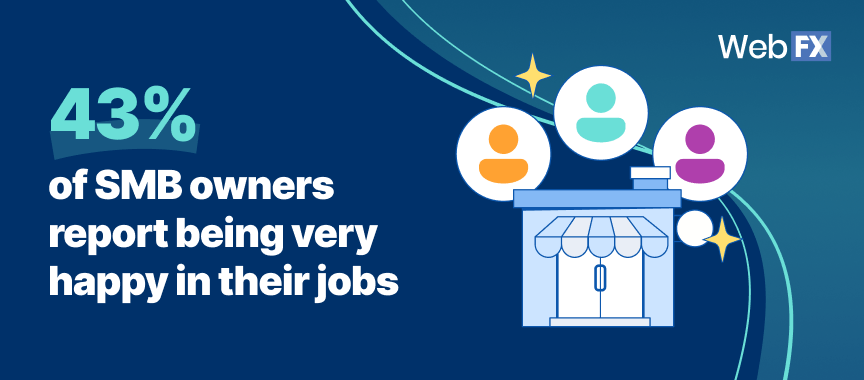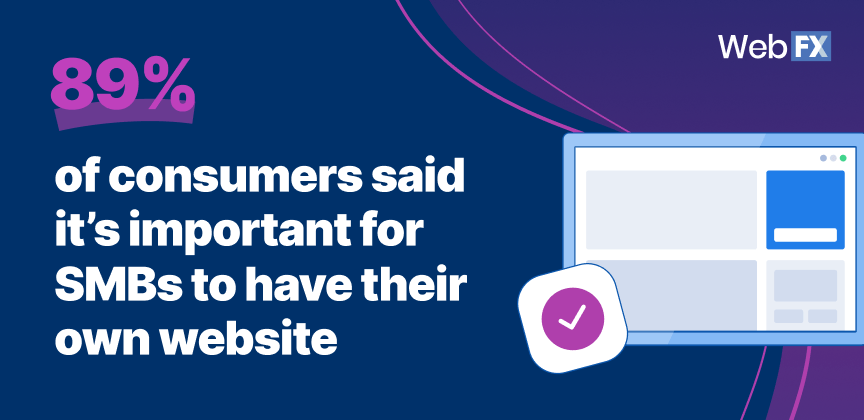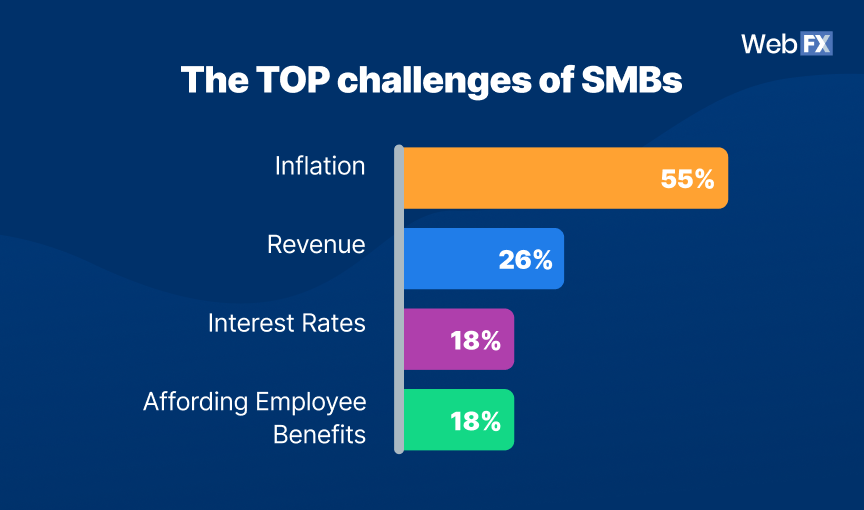-
 Published: Aug 9, 2024
Published: Aug 9, 2024
-
 11 min. read
11 min. read
-
 Matthew Gibbons
Matthew Gibbons Senior Data & Tech Writer
Senior Data & Tech Writer
- Matthew is a marketing expert focusing on the SEO & martech spaces. He has written over 500 marketing guides and video scripts for the WebFX YouTube channel. When he’s not striving to put out some fresh blog posts and articles, he’s usually fueling his Tolkien obsession or working on miscellaneous creative projects.
When you look at today’s economy, it’s easy to assume that it’s dominated by large corporations. But much of the marketplace, both physical and online, is taken up by small businesses just like yours.
With small businesses being such significant contributors to the economy, it can be helpful to look at some numbers related to their larger role and what you can expect as the owner of one. That’s why we’ve compiled small business statistics in 2025 and sorted them below:
- General small business statistics
- Benefits of having a small business
- Consumers’ views of small businesses
- Statistics related to the challenges of running a small business
- Small businesses and digital marketing
- Small business statistics related to artificial intelligence (AI)
Keep reading to start learning from these statistics for small businesses. Then subscribe to Revenue Weekly, our email newsletter, to get even more helpful marketing content delivered straight to your inbox!
General statistics for small businesses
The first type of small business statistics we’ll look at is general small- to medium-sized business (SMB) stats. These stats give you a general picture of the role small businesses play in the economy. Read on to learn more!
1. There are 33.2 million small businesses in the United States, making up 99.9% of all U.S. businesses.
While small businesses might not have the same kind of advertising power as massive corporations, they make up very nearly all the companies in the U.S.
2. Small businesses have created 17.3 million net new jobs from 1995 to 2021.
SMBs have created more net new jobs than large businesses. In fact, small businesses have accounted for almost 63% of net new jobs since 1995.
3. Micro businesses — businesses with four employees or fewer — account for 56% of small businesses in the United States.
This indicates that your company doesn’t necessarily have to be stocked with tons of employees to succeed. Most small businesses get by with very few workers!
4. Small business employees account for 46.4% of all U.S. employees.
Just like the previous statistic, this one indicates just how much influence small businesses have over the marketplace — in this case, over employment. There are 61.7 million small business employees in the country.
Benefits of small businesses
In this next section, we’ll look at SMB statistics related to the benefits of small businesses. These benefits affect owners, customers, and the market.

5. 92% of small business owners say they don’t have any regrets about starting their company.
In the same vein as the previous stat, most small business owners indicate that they’re glad they started their small business and don’t regret doing so.
6. 84% of small business owners say that they feel optimistic about their companies going into the future.
Not only do small business owners feel good about starting their companies, but they also feel good about the future of their business. Most small business owners are optimistic about their companies’ future success.
7. 73% of small businesses say they expect their revenue to increase in 2025.
SMBs are optimistic about the future. In fact, 73% of small businesses are also comfortable with their cash flow in the second quarter of 2024.
8. 43% of small business owners report being very happy in their jobs.
This statistic indicates that running a small business has the potential to be a very fulfilling career path, perhaps leading to more job satisfaction for some people than working for a larger company.
9. 29% of small business owners said they opened their own business so they could be their own boss.
According to the study that provided this statistic, one of the most common motivations for starting a new business is that it lets business owners be their own boss rather than working under someone else.
10. Small businesses have accounted for two out of every three new jobs in the past 25 years.
Small businesses don’t just benefit their owners — they also benefit the job market. They create new jobs each year, providing opportunities for people looking for jobs.
Consumers’ views of small businesses
How do consumers view SMBs? What would make them shop at small businesses rather than larger businesses? Let’s find the answers from these SMB statistics:
11. 89% of consumers said it’s important for small businesses to have their own website.
Consumers want to learn more about small businesses’ offerings and their brand story, but 24% of small businesses surveyed didn’t have their own website.
With the aid of a website, small businesses can nurture their relationships with their prospects, share their brand stories, and provide product details.
12. 73% of Generation Z and 75% of millennials say that they’d shop more at small businesses if they offered the same convenience as larger stores.
For Gen Z and millennials, convenience is important when shopping. Contactless digital payments and “buy online, pick up in-store” are some of the convenience features they’re looking for.
Contactless payment is important for 85% of Gen Z and 82% of millennial shoppers. Meanwhile, “buy online, pick up in-store” is important for 73% of Gen Z and 83% of millennials.

13. 65% of consumers said they’re more likely to purchase from a small business if they knew the personal story of the SMB.
SMBs can nurture their relationships with their target audience by sharing their personal story. Video marketing and content marketing are excellent strategies to engage your audience.
14. 47% of American consumers shop at small businesses between two and four times each week.
This statistic indicates a benefit for both consumers and business owners. It shows that consumers continually support small businesses, and that routine shopping also indicates a steady stream of revenue for business owners.
The challenges of small businesses
As beneficial as small businesses are for everyone involved, they still come with challenges. Here are some statistics for small businesses like yours to watch.
15. 55% of SMBs say inflation is the top challenge facing their community.
Inflation is the top concern of small businesses, followed by revenue, which is named as a challenge by 26% of the community. Interest rates (18%) and affording employee benefits (18%) are also some of the concerns of SMBs.
16. Over 20% of small businesses fail in the very first year, while almost 50% of startups fail within the first five.
This statistic can seem incredibly discouraging, but it’s necessary to understand the risks. This stat is in no way suggesting that your business will fail — it’s clarifying that driving success for your business will require time and effort. It won’t be as easy as kicking back and waiting for revenue without overcoming sales challenges!

17. An average of 1 in 12 small businesses closes each year.
Not all small businesses will last for a long time. Small businesses can close due to high costs, lack of demand, or owner retirement, amongst other reasons.
The shifting economy plays an integral role in leading small business owners to close up shop, so it’s important that your business stays flexible and current to survive economic change.
18. 19% of small business owners spend over 60 hours working each week.
This statistic shows just how much work it takes to run a small business. With some business owners having to spend 60 hours a week at their jobs — twice as much as employees of larger businesses — it’s no small commitment.
Small businesses and digital marketing
We’ve explored general SMB stats, along with the benefits and challenges of running a small business. To conclude, let’s examine the role marketing plays for small businesses. Here are some key marketing statistics that can help you determine if your SMB should invest in digital marketing.
19. 80% of small businesses’ marketing teams adapt their strategies based on customer interactions.
Marketers of SMBs know the importance of personalization to attract and retain customers. To show that businesses understand the needs of their audience, they must adapt their strategies based on their customer’ needs and interactions.
20. 70–80% of consumers will research a small business online before contacting it in any way.
This statistic points to the importance of developing a strong online presence for your business. That means building a website, trying out different online advertising strategies, and curating positive reviews for your company online.
21. 64% of small business service professionals claim that all their departments use the same customer relationship management (CRM) platform to bring their data together.
Businesses are breaking down departmental silos by using a single software to house their customer data. Doing so makes them more efficient and enables them to provide a better customer experience.
22. 47% of all small businesses name marketing as their primary strategy for growth.
Nearly half of all businesses recognize that marketing can help them increase the size of their company, and you should too! Marketing drives sales, which brings revenue, which in turn stimulates growth.
23. 36% of small businesses don’t have their own website.
In today’s digital world, any business without a website will struggle to generate leads online — and yet, 36% of small businesses still don’t have their own site. If you don’t already have a website for your small business, you’ll want to create one to help boost growth.
24. 31% of small business owners say that their primary marketing goal is to drive sales.
There are different goals you can set for your marketing. Sometimes marketers aim to spread brand awareness or embed their business within the community. But for small businesses, one of the main goals is also the simplest — to use marketing to directly encourage prospects to make purchases.
Bonus Read: Should Your SMB Invest In Digital Marketing?
SMB statistics related to AI
Small businesses are no strangers to artificial intelligence (AI) tools. Here are SMB statistics related to AI to prove their optimism toward it:
25. 74% of SMBs believe that having employees who use AI tools could give them an edge against their competitors.
The majority of small businesses are optimistic about AI, as this stat shows. Their optimism outweighs the concerns surrounding AI.
26. 71% of small businesses believe that hiring people with AI skills will save them time.
In general, SMBs are optimistic about the future of AI that they’re optimistic about the time savings that people with AI skills can bring to their team.
27. 67% of SMBs believe that hiring employees with AI skills will save them money in the long run.
Similar to the previous stat, this data reveals that small businesses believe that using AI can help their companies.
28. 65% of small businesses say they expect AI to change the roles of their staff in the future.
SMBs believe that AI will reshape the workforce in the future. In fact, 64% of small businesses expect AI proficiency to be included in future job postings.
29. 62% of small businesses’ workers believe that generative AI can help them serve customers better.
Generative AI can help small businesses provide a personalized experience to their customers. In addition, SMBs can use it to streamline their workflows and as a chatbot to automate certain customer interactions.
30. 49% of small businesses claim they plan to try AI tools in 2025.
As more SMBs become familiar with AI tools, they’re open to trying them next year.
31. 40% of SMBs have tried different AI tools to suit their needs.
There are several AI tools available for businesses of different sizes and industries. Small businesses can choose from AI sales assistant software to AI copywriting tools.
32. 24% of SMBs say they plan to develop or update an AI company policy in 2025.
Small businesses are in the early stages of adopting AI. As they try and implement these new tools, they understand the need to update or create company policies on AI use.
Our digital marketing campaigns impact the metrics that improve your bottom line.
See Our Approach
$10 billion

24 million

7.14 million
WebFX can help your small business drive revenue through marketing
Want some help applying what you’ve learned from these SMB stats to beef up your marketing campaigns? Let WebFX help you! With over 1,100 client testimonials speaking to the quality of our service, you can rest assured that we can drive revenue for your small business.
With our digital marketing services, you’ll get help optimizing everything from your website to your social media efforts. To get started with us, just call 888-601-5359 or contact us online today!
-
 Matthew is a marketing expert focusing on the SEO & martech spaces. He has written over 500 marketing guides and video scripts for the WebFX YouTube channel. When he’s not striving to put out some fresh blog posts and articles, he’s usually fueling his Tolkien obsession or working on miscellaneous creative projects.
Matthew is a marketing expert focusing on the SEO & martech spaces. He has written over 500 marketing guides and video scripts for the WebFX YouTube channel. When he’s not striving to put out some fresh blog posts and articles, he’s usually fueling his Tolkien obsession or working on miscellaneous creative projects. -

WebFX is a full-service marketing agency with 1,100+ client reviews and a 4.9-star rating on Clutch! Find out how our expert team and revenue-accelerating tech can drive results for you! Learn more
Try our free Marketing Calculator
Craft a tailored online marketing strategy! Utilize our free Internet marketing calculator for a custom plan based on your location, reach, timeframe, and budget.
Plan Your Marketing Budget

Proven Marketing Strategies

Proven Marketing Strategies
Try our free Marketing Calculator
Craft a tailored online marketing strategy! Utilize our free Internet marketing calculator for a custom plan based on your location, reach, timeframe, and budget.
Plan Your Marketing Budget
What to read next





